In the latest Biblical Archaeology Review (Jan./Feb. 2016), Peter Schertz and Steven Fine wrote an interesting article called “A Temple’s Golden Anniversary”. The anniversary they refer to is that of the well-known model of Jerusalem in the Second Temple period that at present is located in the Israel Museum and will be 50 years old in 2016.
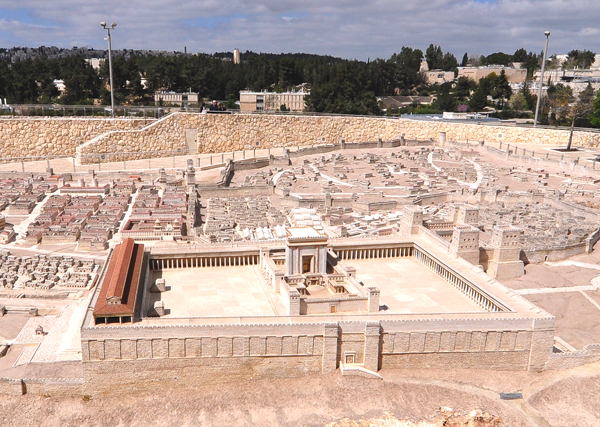
In 1966, Prof. Avi-Yonah completed a 4-year project of creating a model of Second Temple Jerusalem built to a scale of 1:50. It was commissioned by Hans Kroch, owner of the Holyland Hotel, in memory of his son Jacob, who was killed in the 1948 Arab-Israeli War. In 2006 the model was dismantled and rebuilt in the grounds of the Israel Museum in Jerusalem. This model and especially the section that depicts the Temple became so popular that it became “the standard image of the Second Temple for Jews and Christians alike.”
The authors describe the Temple complex in great detail and show that Avi-Yonah, in his research for this model, used the descriptions by Josephus, contemporary architectural styles, such as that of the Tomb of the Patriarchs in Hebron and other sites, and depictions on coins, such as those issued during the Bar Kochba Revolt (133-135 AD) that show a Temple façade with a flat roof supported by four columns.

In the article however, there is a strong focus on the gold of Herod’s Temple:
“How much gold decorated the Temple is also a matter of debate. Josephus describes the Temple façade as covered with ‘massive plates of gold’ and writes that a large golden vine hung with golden fruit above the large door leading to the inner sanctum. … Avi-Yonah took a rather conservative stance toward gold, using it for external trim, but not as a facing for the Temple, nor did he include the golden vine in his reconstruction.”
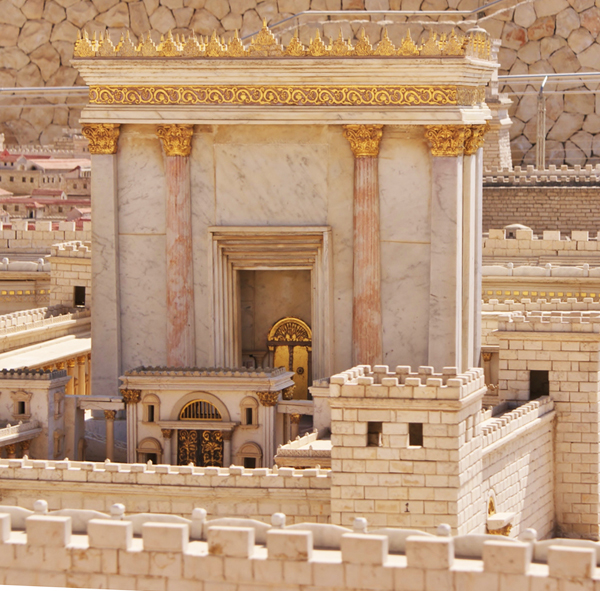
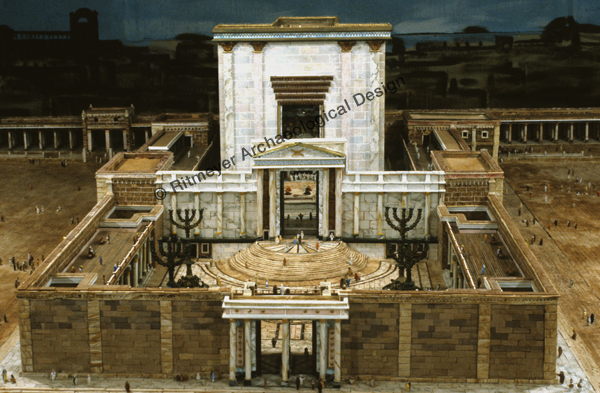
In their article, the authors contrasted Avi-Yonah’s model with the one I designed for the late Benjamin Adelman, Chairman of the American Friends of the Israel Exploration Society in Washington DC. His commission of several models was a wonderful opportunity to put my personal research of many years of study of Jerusalem and the Temple Mount into elegant models of Herod’s Temple, Herod’s Temple Mount, Solomon’s Temple and the Tabernacle. These models were produced in England by a professional modelmaking firm, York Modelmaking and Display Limited and shipped over to Washington. After Adelman’s death, these models were bequeathed to the Yeshiva University Museum in New York.
The authors wrote of my model of Herod’s Temple:
“In contrast to Avi-Yonah, Leen Ritmeyer, the former architect of the archaeological excavations below the Temple Mount, has taken a rather maximalist approach to the Temple gold. His model … covers the entire façade with sheets of gold.”
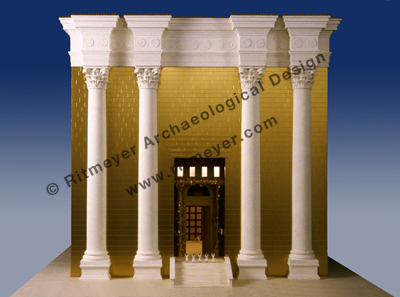
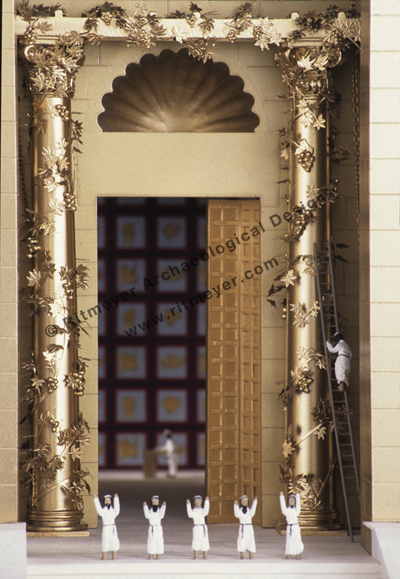
The authors are unsure of which areas were covered with gold and suggest that the description of the Temple by Josephus (see below) is somewhat obscure:
The sacred edifice itself, the holy Temple, in the central position, was approached by a flight of twelve steps. The façade was of equal height and breadth, each being a hundred cubits; but the building behind was narrower … The entire façade was covered with gold, and though it the first edifice [the Sanctuary beyond the Porch] was visible to a spectator without in all its grandeur and the surroundings of the inner gate all gleaming with gold fell beneath his eye …The gate opening … had, moreover, above it those golden vines, from which depended grape clusters as tall as a man; and it had golden doors … The exterior of the building wanted nothing that could astound either mind or eye. For, being covered on all sides with massive plates of gold, the sun was no sooner up than it radiated so fiery a flash that persons straining to look at it were compelled to avert their eyes, as from the solar rays. To approaching strangers it appeared from a distance like a snow-clad mountain; for all that was not overlaid with gold was of the purest white. From its summit protruded sharp golden spikes to prevent birds from settling upon them and polluting the roof. (War 5.207–226 and also Ant. 15.391-395)
From this description one gets the impression that most of the façade was covered with gold, apart from the upper part. To reduce the enormous amount of gold that the use of massive plates would require, it is more likely that a thin gold foil may have been pressed against the stones and the edges tucked in between them. Remains of thin gold foil have been found in other buildings from that period. We know that the top part of the Temple façade, called the entablature, was not covered with gold, because other sources indicate that the exposed limestone blocks were whitewashed once a year. This would confirm Josephus’ description of the Temple facade as a snow-clad mountain.
Josephus is not the only source describing the gold of the Temple. Mishnah Shekalim 4.4 mentions that the surplus of the terumah was used to make “golden plating for bedecking the Holy of Holies.” The terumah was originally a heave-offering of agricultural produce, but is used here as a financial contribution which was taken three times a year and put in the Chamber of the Half-shekel of the Temple. It appears that if enough money was available, golden plates of one cubit square were made and hung on the walls of the Sanctuary, as Middot 4.1 says that “all the House was overlaid with gold.” Some of these plates were put on display during the three main pilgrim festivals.
Another historical reference to the gold of the Temple is to be found in the New Testament (Matt. 23:16,17) where Jesus berates the Pharisees and Scribes who said: “Whosoever shall swear by the temple, it is nothing; but whosoever shall swear by the gold of the temple, he is a debtor!” Jesus reasons that the Temple that sanctified the gold was greater than the gold itself. It appears therefore that the gold of the Temple was well known at that time.
Finally, as mentioned in a previous post, an inscription in Rome suggests that the gold of the Jerusalem Temple was used for the building of the Colosseum. The Colosseum is a very large building and lots of money, in the form of silver and gold, would have been needed for its construction.
We will never know for sure how much gold the Jerusalem Temple contained and exactly where it was displayed, internally and externally. It is generally known that Josephus occasionally exaggerates, but that a large amount of gold was displayed in the Jerusalem Temple, appears to be a reasonable suggestion if we also take other historical sources into consideration.

I don’t think Herod’s Temple (destroyed 70 AD) is depicted on Bar Kochba’s coin. I think this is another temple built by Hadrian around 132-135 AD It’s a typical Roman tetrastyle (four columned) temple, with fluted shaft columns. There is no pediment on the Temple but there is a eight pointed star where the pediment normaly would be. The foundation of the temple, could however be, reused Herodian ashlar stones.
Bar Kochba just replaced whatever Hadrian put within the temple, with a another highly decorated object (maybe golden), venerated by Bar Kochba, as a part of his revolt against Hadrian and the Roman Empire.
The dots on the temple and on the object indicate decorations, the bottom of the object within the temple is never decorated, it’s always a straight line. The object is also, always in mid-air, not on the temple floor.
The object could be, the Ark of the Covenant, seen from the side ? I think it stood sideways in Solomon’s Temple.
Victor,
Most scholars agree that the temple portrayed on the Bar Kochba coins represents the Herodian Temple, which Bar Kochba wanted to rebuild. The star above the temple may represent Bar Kochba (Son of a Star) himself and not necessarily represent a pediment. Some historical sources indicate that a Capitolium, a temple devoted to Jupiter and Juno and Minerva, his two female companions, was built in Jerusalem. A statue of Hadrian may have stood in front of this building. The problem, however, of where it stood in Aelia Capitolina, as Jerusalem was then called, has not been solved satisfactorily. I believe that the three long steps south of the Dome of the Rock on the Temple Mount, observed by Warren in the 1860’s, and apparently made of stones in secondary use, may indicate that a start was made with the building of a crepidoma (stepped platform) for a Roman temple on the Temple Mount, but was never finished (see our latest guide book: Jerusalem the Temple Mount, a Carta guide book, p. 32).
The object in the entrance to the Temple on the coin is a piece of furniture that, according to Prof. Dan Barag, represents the Table of Shewbread. It cannot be the Ark of the Covenant as the object on the coin has legs, which are not mentioned in the biblical description of the Ark Ex. 25:10-22; 37:1-9. You say that the bottom line is always straight, but that is not true. On the Year One coin, the bottom line is decorated with dots, just as the rest of the piece of furniture. On another Bar Kochba coin, a didrachm, the table is shown sideways, with the bottom line also decorated. The two central dots on the tetradrachms probably represent the rings for the staves that were used in carrying the table. I agree that on tetradrachms the long side of the table is shown, as that was the original orientation in the Jewish Temple. The very fact that a Jewish symbol is shown in the entrance to the temple, precludes it from being a Roman one.
Some think that Jesus’ prophecy that “not one stone will be left standing upon another” was fulfilled because so much gold melted amongst the stonework in the fire, that all the stonework had to be picked apart to recover it. I find that convincing. There would otherwise not have been any need to demolish the Temple entirely, to adapt / rededicate it to Jupiter
John,
That may be partially true, but the most common idea is that the Temple was destroyed by the Romans because it came to symbolise the Jewish rebellion against Rome.
Could the two dots on the Table symbolize the two cups of frankincense that were on it? They also seem to be shown on the Table as depicted in the Arch of Titus, so maybe they were considered a central feature.
Also, weren’t the long ends North/South in the Tabernacle (and thus probably the Temple)?
Nacho,
The image on the coin represents the side of the Table of Shewbread and therefore could not represent the cups of incense. I believe that the poles were placed east-west along the long side of the table.
Each year more gold was added inside and out. Was it totally covered in 66? It would not have been reasonable for commentators to record the current area covered, what mattered was that it would all be covered with gold. So they report is that it was covered with gold in the beginning even when it was only a small portion.